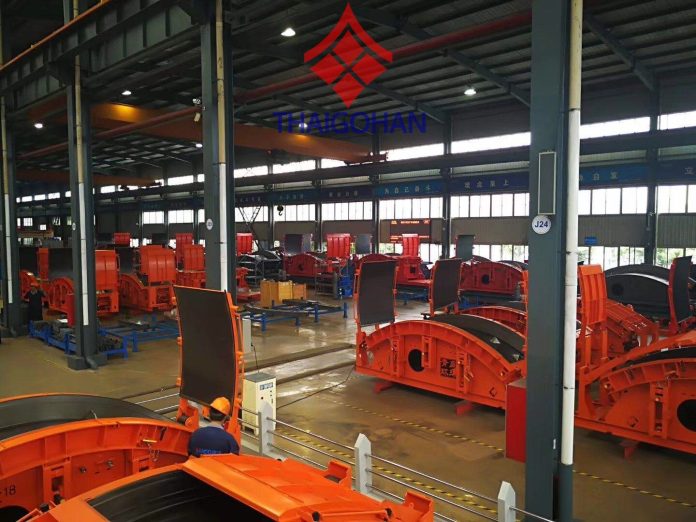The construction of metro tunnels requires cutting-edge technology and precise engineering to ensure the safety and longevity of the underground infrastructure. One of the most vital components in this process is the lining segments, which are used to reinforce the tunnel walls. These segments are created using metro tunnel lining segment moulds, which play a crucial role in determining the quality, durability, and efficiency of the entire construction process. In this article, we will explore how these moulds are enhancing tunnel construction, focusing on their contribution to durability, efficiency, and safety.
The Role of Metro Tunnel Lining Segments
Metro tunnel lining segments are precast concrete elements used to form the structural shell of metro tunnels. These segments are designed to provide essential support and safety for the tunnel structure while also offering solutions to water management, fire resistance, and other environmental challenges.
Key functions of lining segments include:
- Structural Support: The segments hold the tunnel in place, preventing collapse and withstanding external pressures from surrounding soil and rock.
- Waterproofing: Lining segments are designed with waterproofing systems to protect the tunnel from water leakage, which is critical in underground construction.
- Fire Resistance: The segments are often fire-resistant to provide safety in emergencies.
- Smooth Surface: They offer a smooth interior surface for additional infrastructure, such as rail systems, electrical wiring, and ventilation.
How Metro Tunnel Lining Segment Moulds Work
Metro tunnel lining segment moulds are sophisticated devices that shape the precast concrete segments. These moulds must meet the high precision required for tunnel construction, ensuring that the segments fit together perfectly and maintain the structural integrity of the tunnel. Here’s how they work:
1. Mould Design and Customization
Each metro tunnel project may present unique challenges, such as different geological conditions, water table levels, or seismic risks. As a result, lining segment moulds must be designed and customized to meet the specific requirements of the project. Engineers use computer-aided design (CAD) systems to develop precise specifications for each mould, ensuring that the final segments are tailored for the conditions of the specific tunnel.
Customization can include adjusting the size, shape, and thickness of the lining segments, and incorporating special features like waterproofing or fire-resistant coatings.
2. Material Selection and Quality Control
To ensure durability and strength, the materials used in creating the moulds must be of the highest quality. Reinforced steel is commonly used for making moulds, providing resistance to wear and tear during the production process. The concrete that fills the moulds is also specially selected for its strength, durability, and resistance to environmental factors like moisture and fire.
The quality control processes associated with metro tunnel lining segment moulds are rigorous. Automated systems monitor every step of the production, from material preparation to final curing, to ensure that each segment meets the required standards.
3. Automation in the Moulding Process
Modern automation technologies have significantly improved the efficiency of the moulding process. Automated systems monitor the pouring, curing, and removal of concrete segments, ensuring consistency and reducing the risk of human error. This automation also speeds up the process, allowing a larger number of lining segments to be produced in a shorter time frame.
Automation helps to achieve:
- Uniformity: All segments are identical in size, shape, and quality, ensuring a consistent final product.
- Efficiency: The automated process reduces the time and labor required to produce the segments, allowing construction to proceed more quickly.
- Cost Savings: Automation helps minimize waste, defects, and labor costs, making the overall construction project more cost-effective.
4. Durability of Moulds
The moulds used in metro tunnel lining production are designed to endure the harsh conditions of the construction process. High-strength reinforced steel ensures that the moulds can withstand the forces of concrete pouring, as well as repeated use over time.
Durable moulds play a crucial role in maintaining the efficiency and cost-effectiveness of the production process. Well-maintained moulds reduce downtime, prevent defects in the segments, and ensure that each segment meets the required strength and quality standards.
Advantages of Advanced Lining Segment Moulds in Tunnel Construction
Metro tunnel lining segment moulds have revolutionized the way tunnels are constructed, offering numerous benefits to the construction process.
1. Enhanced Durability of the Tunnel Structure
Lining segments are subjected to high pressures from the surrounding earth and water. The precise design and high-quality materials used in metro tunnel lining segment moulds ensure that the resulting segments can withstand these forces. This durability ensures that the tunnel structure remains intact over time, even under extreme conditions.
Additionally, the integration of waterproofing features, fire-resistant coatings, and seismic resistance in the segment design increases the overall safety and longevity of the tunnel.
2. Improved Construction Efficiency
The use of advanced moulds has drastically improved the efficiency of tunnel construction. The automated processes and precise measurements involved in segment production help speed up the production of lining segments. With the ability to produce large quantities of segments quickly and consistently, construction crews can assemble the segments more rapidly, reducing project timelines.
The efficiency of the moulding process also minimizes material waste, ensuring that the construction process remains economical and environmentally sustainable.
3. Customization to Meet Project-Specific Needs
No two metro tunnel projects are exactly alike. The ability to customize the moulds to meet specific project requirements is one of the most significant advantages of modern lining segment moulds. Whether the project requires curved or straight segments, thickened walls for added strength, or segments with integrated drainage systems, customization ensures that the lining segments will meet the needs of the tunnel.
This level of customization improves both the safety and performance of the metro tunnel, adapting to the challenges posed by different geographic and environmental conditions.
4. Cost-Effectiveness
While advanced moulds and automated systems require an initial investment, their ability to produce large quantities of high-quality segments quickly results in significant cost savings in the long run. Faster production times, reduced material waste, and improved consistency lead to a more cost-effective construction process.
Additionally, the durable segments produced by high-quality moulds reduce the need for repairs or replacements, ensuring that the tunnel remains in optimal condition for decades.
5. Sustainability
The use of high-strength concrete and durable moulds results in longer-lasting tunnel linings that require fewer repairs, reducing the environmental impact of construction. Moreover, the automation and precision engineering involved in segment production reduce material waste and energy consumption, contributing to a more sustainable construction process.
Conclusion
Metro tunnel lining segment moulds are at the heart of efficient, durable, and cost-effective tunnel construction. These moulds play a critical role in ensuring that the precast concrete segments used to line the tunnel walls meet the highest standards for strength, safety, and longevity. By enabling precise customization, enhancing construction efficiency, and promoting sustainability, modern moulds are transforming the metro tunnel construction industry. As cities around the world continue to expand their metro systems, the importance of high-quality lining segment moulds in ensuring the success of these large-scale infrastructure projects cannot be overstated.








